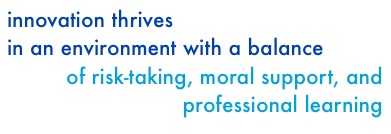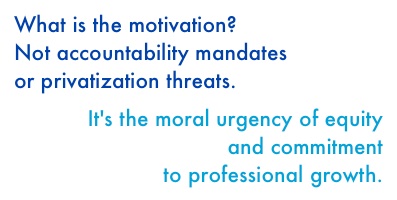What do we mean when we talk about innovation in Vermont education?
 Recently, the #vted Twitter chat focused on innovation, and the conversation brought a mix of practical tips, brilliant insight, and positive sentiment. The take-home message for me was that innovation thrives in an environment with a balance of risk-taking, moral support, and professional learning.
Recently, the #vted Twitter chat focused on innovation, and the conversation brought a mix of practical tips, brilliant insight, and positive sentiment. The take-home message for me was that innovation thrives in an environment with a balance of risk-taking, moral support, and professional learning.
Looking for a definition
Here are some of my favorite definitions of innovation from the #vted Twitter chat:
- “Innovation is something new, something scary, something worthwhile and something exciting.”
- “Innovation is going beyond the comfort zone into risky and potentially fruitful territory.”
- “Innovation is hard work that doesn’t seem like work. Messy learning. Lots of chatter and debate.”
 I have been participating in these chats since I came to Vermont last summer. Each time, I gain great ideas and find professional inspiration.
I have been participating in these chats since I came to Vermont last summer. Each time, I gain great ideas and find professional inspiration.
Along with ongoing collaboration with my Tarrant Institute colleagues and the intensive growth that I’ve experienced alongside the partner teachers and administrators of Washington West Supervisory Union, I feel like I am immersed in innovative practices.
How is innovation defined elsewhere?
Innovation is often associated with technology. Look no further than this blog to see tons of examples of educators creating new learning opportunities in tech-rich environments. Yet even the most enthusiastic tech integrationists recognize that technology will not benefit student learning without major shifts in pedagogy and structures.
There are two other ways innovation is often defined in education:
1. Data-driven decision making
The standards-based reform movement has largely focused on the use of standardized assessment to guide strategic planning and to make high-stakes decisions about students and teachers.
A recent report by the Organization for Economic Cooperation and Development titled ““Measuring Innovation in Education: A New Perspective, Educational Research and Innovation” lists the top U.S. innovations in school organization as:
- More use of student assessments for monitoring school progress
- More use of assessments for national or district benchmarking
- More use of assessment data to inform parents of student progress
- More external evaluation of secondary school classrooms
As pointed out in an Answer Sheet commentary on the report, other countries are moving away from this approach, but “The United States at this point appears to be standing alone in its obsessive use of standardized tests as important measures of accountability in education.”
Please note that being an outlier does not make us innovative.
2. Charter schools
Innovation in U.S. education is frequently equated with charter schools and the injection of entrepreneurship and managerial practices from the private sector.
My experience working in and with charter schools, however, suggests that though these school are often started with good intentions and transformational ideas, they end up seeking legitimacy by either (a) reverting to traditional practices that are more recognizable as school or (b) pursuing demonstrable results via strategies that boost test scores but do not necessarily nurture creativity.
Fast Company magazine, which focuses on innovation, recently ran an article that argued that charter schools are not very good at innovation. As one example, the article questioned the “no excuses” student discipline approach of many charter schools:
No excuses’ has been shown to deliver strong results in math and reading — witness the impressive standardized test scores at Success Academy Charter Schools, among others. But in a world where personalized instruction and socio-emotional learning are gaining traction, the idea that students should be memorizing math concepts by singing in unison — a tactic made famous by KIPP, a charter school pioneer — is beginning to look archaic. Individualization is in, and individualization has not been charters’ strength.
Yes but, Vermont.

It’s interesting to note that while education technology is thriving in Vermont, the other two prevailing notions of innovation in the U.S. are de-emphasized here in the Green Mountain State: there are no charter schools in Vermont and the State Board of Education has warned of the limitations of standardized testing.
Compare Vermont to Massachusetts, where I spent 14 years working in education in a variety of contexts (including private, charter, and public schools, as well as the state agency).
If you look at the #MAedu hashtag, you will find a lot of energetic debate replete with heated rhetoric and shameless advocacy. The discussion centers around two issues: yep, they’re testing and charters schools.
Now, this is not surprising since the Massachusetts policy context involves a recent ruling by the Board of Education to abandon the PARCC testing consortium, along with constant battles over the charter school cap.
But if you scroll back through the education hashtags for these two states, you can’t fail to notice a marked contrast.
#VTed is more positive and inspirational. It is full of uplifting stories about student accomplishments and blog posts presenting rationales for bold moves like getting rid of homework. There are more references to technology, to personalized learning, and ultimately, to genuinely innovative practices.
Meet Washington West

Washington West Supervisory Union (WWSU) is pursuing educational innovation with purpose.
This fall, Tarrant partner schools in WWSU rolled out Personal Learning Plans for every single student in grades 5-8 AND for their teachers. WWSU has committed huge amounts of time and resources to increasing personalization and proficiency based education practices over the next several years.
And what is the motivation? Not accountability mandates or privatization threats. It’s the moral urgency of equity and a commitment to professional growth.
Although educators elsewhere are similarly committed to improvement for the benefit of their students, they are often struggling with stresses and distractions that make it difficult to take risks and unleash creativity.
WWSU is mobilizing a full blown community based conversation about the future of their school system. As a launch point, they will be showing a screening of the film Most Likely to Succeed, which aims to “bring school communities together in re-imagining what our students and teachers are capable of doing.”
Should be an interesting conversation! I look forward to joining it as a community member and innovation advocate.


Defining #innovation in Vermont education with @lifelegeros #vted https://t.co/3wOLfKkktR https://t.co/a0d8M1D8Sf
RT @innovativeEd: Defining #innovation in Vermont education with @lifelegeros #vted https://t.co/3wOLfKkktR https://t.co/a0d8M1D8Sf
Defining innovation in Vermont education https://t.co/EqAQJSNErw #cesuvt
RT @innovativeEd: Defining #innovation in Vermont education with @lifelegeros #vted https://t.co/3wOLfKkktR https://t.co/a0d8M1D8Sf